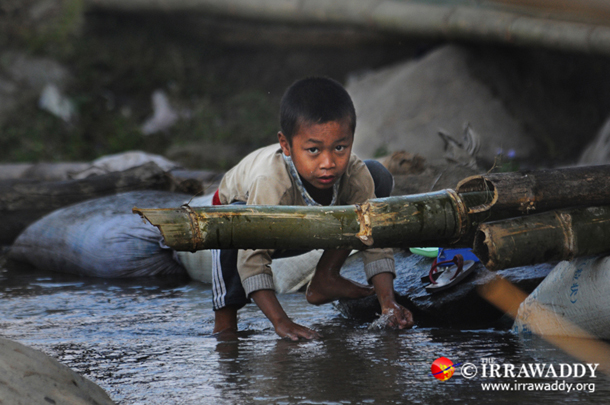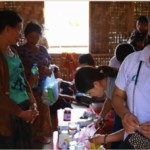Andrew D. Kaspar / The Irrawaddy, March 24, 2014
RANGOON — Burma’s military continues to target civilians in its operations against rebel armed groups in the country, according to a report released Monday by a US-based human rights institute, which recommended a series of reforms to improve the situation.
In a memorandum on “Preventing Indiscriminant Attacks and Wilful Killings of Civilians by the Myanmar Military,” Harvard University’s International Human Rights Clinic (IHRC) said “the Myanmar military continues to prioritize military objectives over civilian protection, including through policies that sanction the direct targeting of civilians.”
That targeting has taken the form of “shoot-on-sight” directives, indiscriminant artillery shelling, extrajudicial killings and use of landmines to inflict civilian casualties, according to the IHRC. The Clinic said the offenses, which constitute violations of international humanitarian law, were part of a “centrally planned counterinsurgency” strategy by Burma’s military, also known as the Tatmadaw.
The 44-page IHRC report emphasized the need to enforce greater accountability for members of the armed forces who inflict civilian casualties, as well as to introduce positive incentives for soldiers who act within the bounds of international humanitarian norms in conflict environments. The IHRC also recommended better training for soldiers who have for decades served a military establishment that has not prioritized human rights.
The IHRC, which has been monitoring the human rights situation in Burma for nearly 10 years, based its memorandum in large part on ongoing research of a counterinsurgency offensive that took place from 2005-08 in eastern Burma, mostly affecting the region’s ethnic Karen population.
The military campaign ostensibly pitted the Tatmadaw against the Karen National Liberation Army (KNLA), but the IHRC said its research “indicated that during the offensive Myanmar Army units largely avoided confrontations with the KNLA and instead pursued civilian targets.”
Matthew Bugher, a clinical advocacy fellow with Harvard Law School’s Human Rights Program, said the IHRC’s findings related to the military’s conduct in Karen State continued to be relevant today, citing civilian casualties and mass displacement in northern Burma in recent years.
“Especially in the last two years, attacks on civilians, civilian targeting, has not gotten enough attention,” he said at a press conference in Rangoon on Monday.
“I do think that the international community should take this issue very seriously, and that engagement on a number of issues in the political sphere, in the military sphere, should be tied to concrete and fundamental reform of the policies that we talk about in this memo,” added Bugher, who helped compile the IHRC report.
Despite progress in reducing fighting between the Tatmadaw and insurgent forces, including the signing of ceasefire agreements with more than a dozen ethnic armed groups since 2011, clashes in Burma’s border regions have occurred with regularity, displacing more than 100,000 civilians and killing an untold number of non-combatants.
Fighting under the reformist government of President Thein Sein has been most recurrent in Kachin State and northern Shan State, where two of the country’s most high-profile armed ethnic rebel groups that have yet to sign ceasefires hold territory.
“
In Kachin State, fighting between Tatmadaw forces and the Kachin Independence Army (KIA) displaced more than 2,000 civilians late last year in Mansi Township. They joined an estimated 100,000 in total that have been displaced since a ceasefire broke down and fighting flared up between the KIA and government troops in mid-2011.
Khon Ja, an activist with the Kachin Peace Network, echoed the IHRC’s assertion that civilians were still subject to the abuses perpetrated during the 2005-08 conflict.
“Exactly the same things are happening in Kachin. It’s repeating, just copy-and-paste. However, when they paste, it has been stronger. That means using more troops, more resources from the government army and bigger damage in the Kachin area,” she told The Irrawaddy on Monday.
The Kachin activist warned that foreign countries’ engagement with an unreformed Tatmadaw would only serve to legitimize the institution’s international standing. Both Britain and the United States have begun initial engagements with the Tatmadaw, focusing on human rights law and related issues that both countries maintain do not further the Burma military’s tactical capabilities.
The memorandum on Monday offered nearly 50 recommendations for changes to policy and practice within the Tatmadaw that it said could decrease civilian casualties and further the country’s three-year-old reform program.
“The fact that these abuses have continued under the current government suggests that the first wave of reform in the country has failed to address fundamental institutional problems within the Myanmar military,” the report said, citing a lingering culture of impunity as central to the problem.
Recommendations include Burma’s accession to UN protocols aimed at protecting civilians in combat situations, and constitutional amendments that would allow for civilian oversight of the military justice system. Its suggested policy changes range from instituting a military promotional and salary structure based on individual soldiers’ protection of civilians, to better human rights training all the way up the chain of command.
Another issue raised by the report, based on its research into the 2005-08 offensive, was a color-coded system of geographic designations that determined the military’s rules of engagement with both armed personnel and civilians in a given area. Under the tripartite system of white, brown and black designations, government soldiers operating in the so-called black zones were ordered to treat civilians and armed combatants indiscriminately, effectively making any human being or manmade structure a target.
“In the front lines, whenever you enter the village . . . and you see anyone, no matter who [they] are, you have to kill them . . . all the Karen people you have to kill,” the report quoted one former soldier as saying, referring to military conduct in black zones.
Leaked government documents and civilian testimony corroborated the existence of the color-coding. The report said IHRC could not verify that the system remains in place today, but asserted that there was a “strong likelihood” that it does in some form, based on the targeting of civilians in Kachin State and elsewhere.
The report acknowledges that the abuses against civilians are, to a degree, the result of a difficult operational environment in which guerilla warfare tactics by ethnic armed groups blur the line between civilian and militant.
“Members of opposition armed groups may sometimes fail to wear uniforms or try to confound the military’s efforts to distinguish them from civilians,” it said. “Nevertheless, these difficulties do not absolve the Myanmar military of its obligations under international humanitarian law nor do they justify inaction on the problems identified.”
Failure to reform would also have important implications as Burma, and countries hosting Burmese refugees, consider an appropriate time to resettle those displaced by decades of civil conflict.
“Many individuals with whom we spoke did not feel safe returning to their homes, and feared that the peace process would fail and civilians would again be targeted en masse,” stated the report. “For many civilians, peace dividends remained elusive.”
This article originally appeared on The Irrawaddy. View the original here.




![‘We Need More [International Support] in Kachin State’: Ah Ze, General Secretary of AKYU — PART 2](https://www.burmalink.org/wp-content/uploads/2018/10/Ah-Ze-in-Kachin-State--150x150.jpg)


